Rules of procedure and court practices shape the contours of civil litigation. The path of a civil case follows a similar trajectory across most civil-law countries; this is also true throughout common-law countries. However, there are considerable variances within each legal tradition. Differences in national civil procedure rules often reflect colonial influences and contemporary reforms. For example, Mexico’s civil procedure is based on the Spanish civil-law system, but in recent years many regions of Mexico have introduced common-law adversarial practices. Similarly, many common-law countries have adopted civil-law practices.
Key Differences in Civil Litigation Between Civil and Common Law Systems
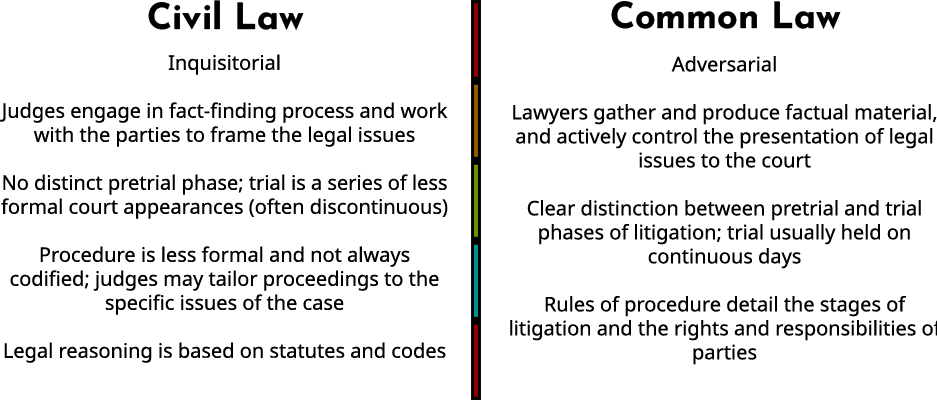
Selecting a Forum
There may be more than one court where a litigant can file a civil action. There are three common structures for national court systems:
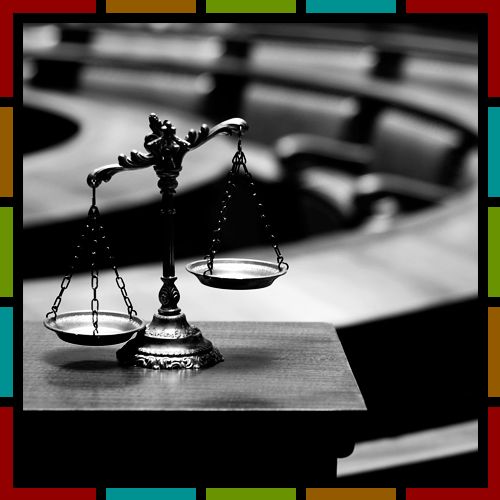
- Dual court systems have overlapping national and regional jurisdiction. For example, in the United States and Australia, there are federal and state or provincial court systems with independent hierarchies. In certain types of cases, both court systems may have jurisdiction over a claim.
- Single court systems have all claims begin in the same lower courts. South Africa and Myanmar have one court system for the entire country.
- Shared/integrated court systems have courts that are integrated along federal and local levels as in India, Germany, and Nigeria. Local governments administer the first-instance courts, and the federal government has responsibility for courts of appeal.
Many countries also have specialized courts with their own appellate structure, as is the case in Germany, Russia, Brazil, and France. However, in England, cases from specialized courts like family court, county courts, and magistrate courts are appealed to regional courts of (general) appeal, like the High Court.

Filing Suit

A civil lawsuit formally begins when the plaintiff files a statement with the court providing information about the underlying facts, jurisdiction, applicable law, and the relief sought.
The first stage in civil litigation is often referred to as “pleadings.” This stage begins with the plaintiff filing the case in court, includes the defendant’s reply, and, in many common-law systems, concludes with pretrial legal motions.
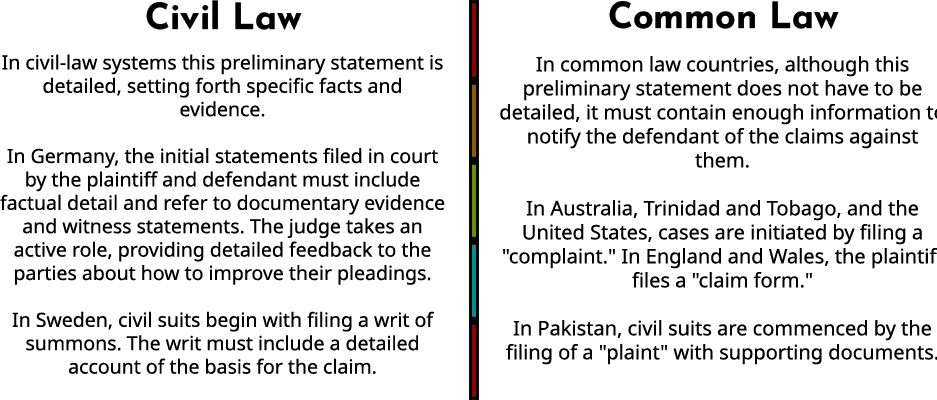

Notice

After a case is filed, the defendant must be notified (or ‘served’ process). Rules for service of process differ by country and can be complicated, depending on where the defendant is located. International agreements outline simplified procedures for serving defendants located abroad, including the Hague Service Convention and the Inter-American Convention on Letters Rogatory.
In Japan, the court is responsible for service–not the plaintiff—through a special type of mail service. In Argentina, service by mail or by a private party is prohibited; the judiciary is primarily responsible for service of process.
Jordan has strict rules about the timing of service: not before 7 a.m., after 7 p.m., or on an official holiday, without permission of the court. In Germany, notice may be served electronically.
In Canada, the complainant must serve the defendant personally or by using an approved alternative.

“Pretrial”
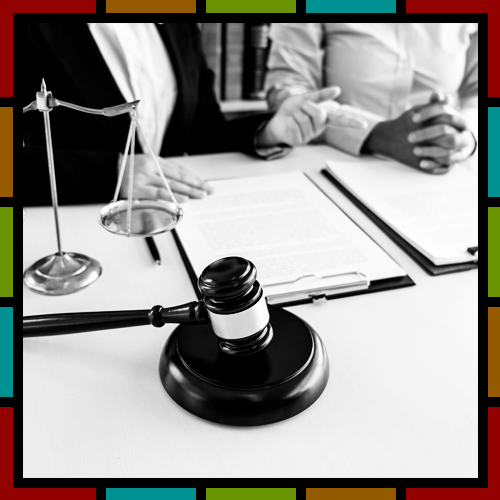
Civil-law systems do not have a clear division between “pretrial” and “trial.” There is often no concept of “pretrial hearings.” Litigation is the trial; it unfolds over time as a series of discrete hearings that include the presentation of evidence as well as legal arguments. The judge takes an active role in narrowing the legal issues and may invite an expert to evaluate the parties’ evidence. If a dispositive legal or factual issue is presented during the hearings, the judge will dismiss the case–the equivalent of a summary judgment ruling.
In contrast, many common-law countries have a lengthy and distinct pretrial phase of litigation where the judge is actively involved. For example, United States judges schedule pretrial conferences with counsel to explore possible areas of agreement on factual issues, narrow the legal claims, and resolve evidentiary issues (see Discovery and Disclosure below). Judges also use these conferences to facilitate settlement discussions. Canadian courts also use pretrial conferences as a tool to manage litigation. A pretrial conference can be requested by the parties or ordered by the judge. In Ontario, they are mandatory in all civil proceedings. The judiciary of Jamaica has introduced mandatory pretrial case-management conferences for civil litigation.
The majority of civil cases filed in the United States conclude before trial: they are either resolved through pretrial motions or during settlement negotiations.
During pretrial “motion practice,” the parties file legal arguments addressing a range of issues, including expert testimony and foreign law. The defendant often files a motion to dismiss, sometimes called "judgment on the pleadings." Motions to dismiss may allege lack of jurisdiction or failure to raise a legitimate legal claim.
At the conclusion of the pretrial phase, after the parties have exchanged evidence, they may file a motion for summary judgment. This legal motion argues that there are no material facts in dispute, trial is unnecessary, and the party submitting the summary judgment motion should prevail as a matter of law. South Africa’s summary judgment rules enable defendants to amend their pleas in response to a plaintiff’s motion for summary judgment. Some countries limit the use of summary judgment. For example, in Malaysia, summary judgment is not available in suits against the government and for certain types of claims, including fraud, libel, slander, and malicious prosecution.

Summary Proceedings
Civil-law systems have procedural mechanisms to resolve disputes without a full trial. For example, the Italian civil code allows debt collection proceedings to be avoided entirely if the creditor comes to court with documentary proof of a right to payment. The debtor has the right to challenge the judgment in a subsequent action. In Germany and Japan, claims based entirely on negotiable instruments and similar documents will undergo accelerated procedures. In all these cases, only documentary evidence is accepted. Many jurisdictions, including the U.S. state courts, have procedural rules enabling small claims to be expedited. For example, New York state courts have implemented an accelerated adjudication procedure for certain types of civil claims.

Evidence: Discovery and Disclosure
In common-law systems, the collection and exchange of evidence takes place during a discrete pretrial stage called discovery. Rules of procedure usually prescribe what evidence is discoverable and what evidence is admissible. The parties are required to share (or disclose) relevant evidence and can request evidence in the possession of the opposing side. South Africa, Canada, England, New Zealand, Australia, and India have procedures for pretrial discovery.
The United States has a complex (and costly) discovery phase. Parties are permitted to request all relevant evidence, a process that often involves voluminous amounts of data. They also can oppose their adversary’s discovery requests. This back and forth sometimes leads to protracted pretrial litigation. Although the U.S. permits broad discovery, not all “discoverable” evidence is admissible at trial.

Depositions
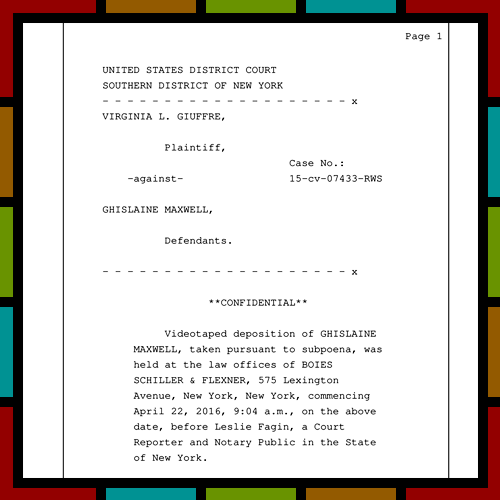
In Canada and the United States, depositions are frequently used to obtain witness testimony. Depositions are sworn, out-of-court witness interviews. Parties request deposition transcripts to assist with trial preparation and create a record that may be used during pretrial motion or impeachment of a witness at trial. Depositions take place out of court with the witness, attorneys for both sides, and a stenographer in attendance, but no judge. Many countries prohibit or limit depositions within their borders.
- Russia and Austria prohibit depositions
- Denmark permits depositions only with special permission from the Ministry of Justice
- Brazil and China do not permit foreigners to take depositions
- Japan and Germany require depositions by foreign attorneys to take place at the foreign attorneys’ consulate.
Most civil-law countries do not have a distinct discovery phase, and in most of these countries, disclosure requirements are generally narrower and less systematic. Courts seek to provide access to evidence where a disparity of information between the parties threatens to impede justice. However, this is done on an ad hoc basis rather than pursuant to specific rules.
Parties are required to submit all evidence they will rely on during trial proceedings, a series of hearings. Many countries do not have mandatory disclosure: litigants are not required to disclose all documents in their possession that are related to the action. Parties must submit specific requests for documents and other evidence to the judge; the judge determines whether the opposing party is required to disclose the requested evidence. In Japan, for example, document discovery is very limited, but a party may petition the court to request disclosure of a specific document.
Some countries have begun to require broader mandatory disclosures. In France, mandatory disclosure requirements can apply to third parties and can take place before litigation is commenced.
Despite more limited disclosure of evidence, most countries have fewer restrictions on admissibility. For example, hearsay and opinion are more freely permitted during civil trials in Sweden, Hong Kong, and Germany.

Preservation of Evidence
In common-law countries, doctrine and rules of procedure govern the preservation of evidence. Parties are required to preserve documents and electronic information that may be relevant to the litigation. In civil-law countries, no comparable doctrine exists, but countries have established mechanisms to assist parties with preserving evidence that may be destroyed or lost at a later time. For example, in China, the court may, either on its own initiative or upon request by a party, take measures to preserve evidence including by requiring the payment of a specific sum as security. In France, a party may ask a Bailiff to establish a statement of facts, such as the location of goods. Plaintiffs in Germany can apply for the preservation of evidence, enlisting an expert to undertake this preservation, even without the consent of the defendant.
Witness Statements


First-Instance (Trial) Proceedings
Judges, Juries, Lay Assessors
The United States is the only country to regularly use juries in civil cases. England and Wales have jury trials for select legal issues, including libel, false imprisonment, malicious prosecution, or fraud. They also use lay judges (called magistrates or Justices of the Peace)–community members who volunteer and serve on panels to adjudicate minor criminal cases and some types of civil cases (licensing appeals, tax, and family law). Most common-law countries only guarantee jury trials for criminal cases, with civil cases decided entirely by judges in what are referred to as “bench trials.”
In civil-law countries, most civil disputes are adjudicated by professional judges. However, some countries have mixed tribunals, where lay judges (sometimes called assessors) serve on a panel with a professional judge. Mixed tribunals are used in many European countries including Belgium, Bulgaria, Denmark, Finland, Greece, and the United Kingdom.

Lay assessors may be ordinary citizens or have specialized expertise, depending on the type of case. For example, Austria uses lay assessors for most civil cases and lay judges with expertise for labor and social law cases. Lay assessors often serve for a period of time, hearing multiple cases over a term rather than a single case. They are compensated for their time. In Hungary, lay judges serve on panels with professional judges; they are publicly elected for four-year terms. In Sweden, lay judges also participate in decision making in administrative courts and at the appellate level. Lay judges are elected by political parties.
Argentina is considering a proposal to introduce jury trials for certain civil cases. Some provinces are moving head of the federal government; in 2020, Chaco province authorized twelve-member jury trials for litigation involving class actions, consumer protection, torts, land disputes, and environmental cases. Some civil trials implicating the interests of indigenous communities must have juries composed of indigenous peoples.
Standard of Proof
In common-law systems, civil cases must be proven by a preponderance of the evidence, meaning that the plaintiff must prove their case to be more likely true than not. In civil-law systems, the standard of proof is higher. Judges must be firmly convinced that alleged facts are true.
Division of Labor: Judge and Lawyers
Judges in civil- and common-law countries have similar responsibilities. They direct the process of narrowing issues of law and fact, supervise the collection of evidence, and determine the admissibility and relevance of evidence proposed by the parties. Lawyers are active participants in the litigation, responsible for strategic decisions, and for framing the issues.
However, in most common-law countries, the attorneys actively direct the sequence of the case and the evidence that will be presented and considered. Judges resolve disputes when parties raise legal and evidentiary arguments. Judges are prohibited from independently researching factual issues; they may only consider evidence put forward by the parties.
By contrast, judges in civil-law jurisdictions actively guide the process of gathering evidence and determine its relevance and order of presentation at trial. Judges typically do not conduct independent investigation in civil cases, except in China, where the court may investigate and collect evidence that it deems necessary and that the parties cannot easily obtain.
The Trial

In common-law countries, trials are usually continuous: all testimony, evidence, and legal arguments are presented over the course of consecutive days. Witnesses who gave deposition testimony or submitted an affidavit pretrial must give testimony during trial (unless they are unavailable). The trial concludes with a verdict. Complex non-jury cases may be scheduled discontinuously, if necessary.
In a common-law trial, plaintiffs present their case first and defendants are permitted to respond. The general order of a trial is as follows: opening statements, presentation of evidence and witnesses, cross-examination of witnesses, and closing arguments. Lawyers question the witnesses and determine the order in which evidence and testimony is presented. Trial is adjourned for the jury or the judge to reach a decision.
Trials in civil law countries are less formal, often resembling case conferences. When the investigation concludes, there is a series of hearings with counsel and the judge (or judges). It is often the judge, not the attorneys, who questions witnesses.
First-instance proceedings, which serve the same purpose as a common law trial, are usually conducted through a series of discontinuous hearings. These hearings may be scheduled over the course of a few weeks, often resulting in evidence being presented out of order. The court will hear witnesses based on availability, regardless of whether they are witnesses for the plaintiff or the defense.
The Record

Alternative Dispute Resolution
Most judicial systems have introduced alternative dispute resolution for civil cases. Methods include mediation and arbitration. Some countries have made mediation mandatory, either before a claim is formally filed or just after. This list includes Italy, Belgium, the United States, Canada, Australia, and Singapore. A new treaty, the United Nations Convention on International Settlement Agreements Resulting from Mediation, establishes a framework for enforcing mediated agreements and has been signed by 48 countries, including the United States and China.

Judgment
After the court has considered the evidence and the applicable law, it issues binding judgment on the parties. In civil-law countries, judges provide a written, reasoned decision. In common law countries with no juries, judges may deliver judgments orally or through a written decision. A hearing may be scheduled for the judge to read their decision. This is recorded by a court reporter and becomes part of the record for the appeal.
A final judgment may involve the payment of money, seizure of property, or an order to do or refrain from an activity. There are different national models for the enforcement of domestic civil judgments.


Appeal
Scope of Review
In common-law countries, appellate courts do not take witness testimony, accept new evidence, or consider new legal arguments. With rare exception, they also do not engage in fact finding. Appellate review is limited to analyzing the trial record to assess whether the judgment was legally sound; additional fact finding is usually not permitted. In the United States, First Amendment cases are one of the rare exceptions to the rule that appeals courts may not make determinations of fact.
If the trial court made an error of law but came to the right outcome, the legal error may be considered “harmless,” and the ultimate judgment is affirmed. A judgment also may be affirmed if the legal error raised on appeal was not brought to the attention of the court during trial or was waived by the losing party. A losing party has one appeal of right, but the final court of appeal may have discretion to decide which cases to hear. However, appeals are rare in many common law countries, due to the excessive cost of litigation.

Appeals are more common in civil law countries, and they are not limited to review of legal issues. Appellate courts may consider new facts, new evidence, new defenses, or new legal arguments. There are usually at least two higher courts that consider appeals. In some countries, including Egypt, France, Italy, Congo, and Bulgaria, the court of cassation is the final court of review for legal issues; courts of cassation usually do not have discretion to reject an appeal.
Decision and Dissent
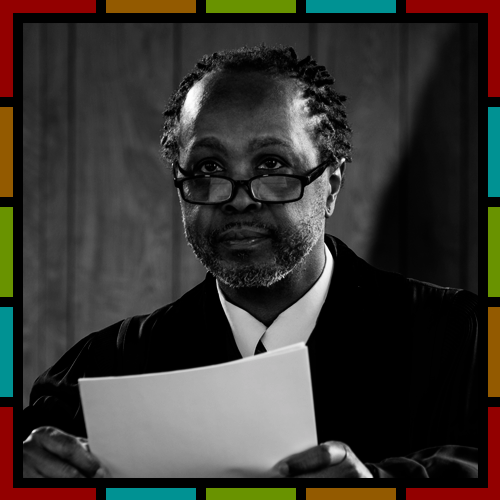
In civil-law countries, procedural rules usually require an extensive, reasoned written opinion. In many countries, these decisions are delivered per curiam, for the entirety of the court, with no concurrence or dissent. In most countries, no information is provided as to how individual judges voted. In Italy, judgments are delivered by the court as a whole. Dissenting opinions may be recorded with a justification, but they are usually sealed and not made available to the public. France, Belgium, and the Netherlands also prohibit public dissenting opinions. This rule has been abandoned in Spain and Brazil; both now publish the vote of each judge and any dissenting opinions.








